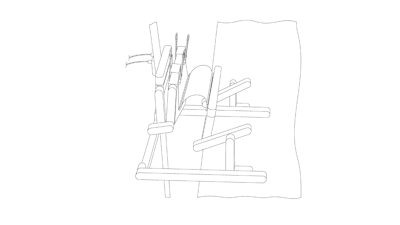Innovations in genome engineering, actuator and elastomer technology and more
To realize its overarching goal to invent and commercialize disruptive solutions for healthcare, energy, architecture, robotics, and manufacturing, the Wyss Institute is creating a patent portfolio in relevant areas that are or can become an essential basis for specific business development and commercialization efforts. To learn more about these innovations, contact our Business Development Team.
The Wyss Institute’s U.S. patents issued between January and March 2016 are as follows:
Compositions of toehold primer duplexes and methods of use
U.S. Patent 9,284,602 (March 15, 2016)
David Yu Zhang and Peng Yin
Abstract: Provided herein are primers and primer systems having improved specificity and kinetics over existing primers, and methods of use thereof.

RNA-guided transcriptional regulation
U.S. Patent 9,267,135 (February 23, 2016)
George M. Church, Prashant G. Mali, and Kevin M. Esvelt
Abstract: Methods of modulating expression of a target nucleic acid in a cell are provided including introducing into the cell a first foreign nucleic acid encoding one or more RNAs complementary to DNA, wherein the DNA includes the target nucleic acid, introducing into the cell a second foreign nucleic acid encoding a nuclease-null Cas9 protein that binds to the DNA and is guided by the one or more RNAs, introducing into the cell a third foreign nucleic acid encoding a transcriptional regulator protein or domain, wherein the one or more RNAs, the nuclease-null Cas9 protein, and the transcriptional regulator protein or domain are expressed, wherein the one or more RNAs, the nuclease-null Cas9 protein and the transcriptional regulator protein or domain co-localize to the DNA and wherein the transcriptional regulator protein or domain regulates expression of the target nucleic acid.
RNA-guided human genome engineering
U.S. Patent 9,260,723 (February 16, 2016)
Prashant G. Mali, George M. Church, and Luhan Yang
Abstract: A method of altering a eukaryotic cell is provided including transfecting the eukaryotic cell with a nucleic acid encoding RNA complementary to genomic DNA of the eukaryotic cell, transfecting the eukaryotic cell with a nucleic acid encoding an enzyme that interacts with the RNA and cleaves the genomic DNA in a site specific manner, wherein the cell expresses the RNA and the enzyme, the RNA binds to complementary genomic DNA and the enzyme cleaves the genomic DNA in a site specific manner.
System and method for efficient drive of capacitive actuators with voltage amplification
U.S. Patent 9,257,936 (February 9, 2016)
Michael Karpelson, Robert J. Wood, and Gu-Yeon Wei
Abstract: A circuit for driving a plurality of capacitive actuators, the circuit having a low-voltage side, a high voltage side and a flyback transformer between the two. The low-voltage side comprises first and second pairs of low-side switches connected in series across an input voltage. The flyback transformer has a primary winding connected to the two pairs of switches. The high-voltage side has a pair of switches connected between the secondary winding of the flyback transformer and a ground and a plurality of capacitive loads and bidirectional switches to connect the loads to the secondary winding of the flyback transformer and a ground.

Bacterial spore based energy system
U.S. Patent 9,234,508 (January 12, 2016)
Ozgur Sahin
Abstract: A method and system for providing an engine for producing mechanical energy through the absorption and evaporation of moisture uses a hygroscopic material in one or more configurations to do mechanical work. The hygroscopic material can include microbial spores, plant cells and cell materials, silk and hydrogel materials that absorb moisture and expand or swell when exposed to high relative humidity environments and shrink or return to nearly their original size or shape when exposed to low relative humidity environments wherein the moisture evaporates and is released. By exposing the hygroscopic material to a cycle of high relative humidity environments and low relative humidity environments, useful work can be done. One or more transmission elements can be used to couple the hygroscopic material to a generator that converts the mechanical energy to, for example, electrical energy. The hygroscopic material can be applied to flexible sheet materials that flex as the hygroscopic material absorbs or evaporates moisture. The hygroscopic material can also be applied to elastic conductive materials, such that the plates of a capacitor mechanically change the capacitance of the device.
Environmentally responsive optical microstructured hybrid actuator assemblies and applications thereof
U.S. Patent 9,229,218 (January 5, 2016)
Joanna Aizenberg, Michael Aizenberg, and Philseok Kim
Abstract: Microstructured hybrid actuator assemblies in which microactuators carrying designed surface properties to be revealed upon actuation are embedded in a layer of responsive materials. The microactuators in a microactuator array reversibly change their configuration in response to a change in the environment without requiring an external power source to switch their optical properties.
Non-differential elastomer curvature sensor
U.S. Patent 9,228,822 (January 5, 2016)
Carmel Majidi, Rebecca K. Kramer, and Robert J. Wood
Abstract: A hyperelastic, soft microfluidic film measures bending curvature using a novel non-differential mechanism. Disclosed embodiments of the elastomer-based solution allows for curvature sensing directly on a bending plane and thus eliminates limitations imposed by strain gauge factor (GF) and sensor thickness (Z). Due to soft lithography microfabrication and design methods the disclosed curvature sensors are elastically soft (modulus 0.1-1 MPa) and stretchable (100-1000% strain). In contrast to existing curvature sensors that measure differential strain, embodiments of the present invention measures curvature directly and allows for arbitrary gauge factor and film thickness. Moreover, the sensor is composed entirely of soft elastomer (PDMS or Ecoflex® and conductive liquid (eutectic gallium indium, (eGaIn)) and thus remains functional even when stretched to several times its natural length. Electrical resistance in the embedded eGaIn microchannel is measured as a function of bending curvature for a variety of sensor designs.
